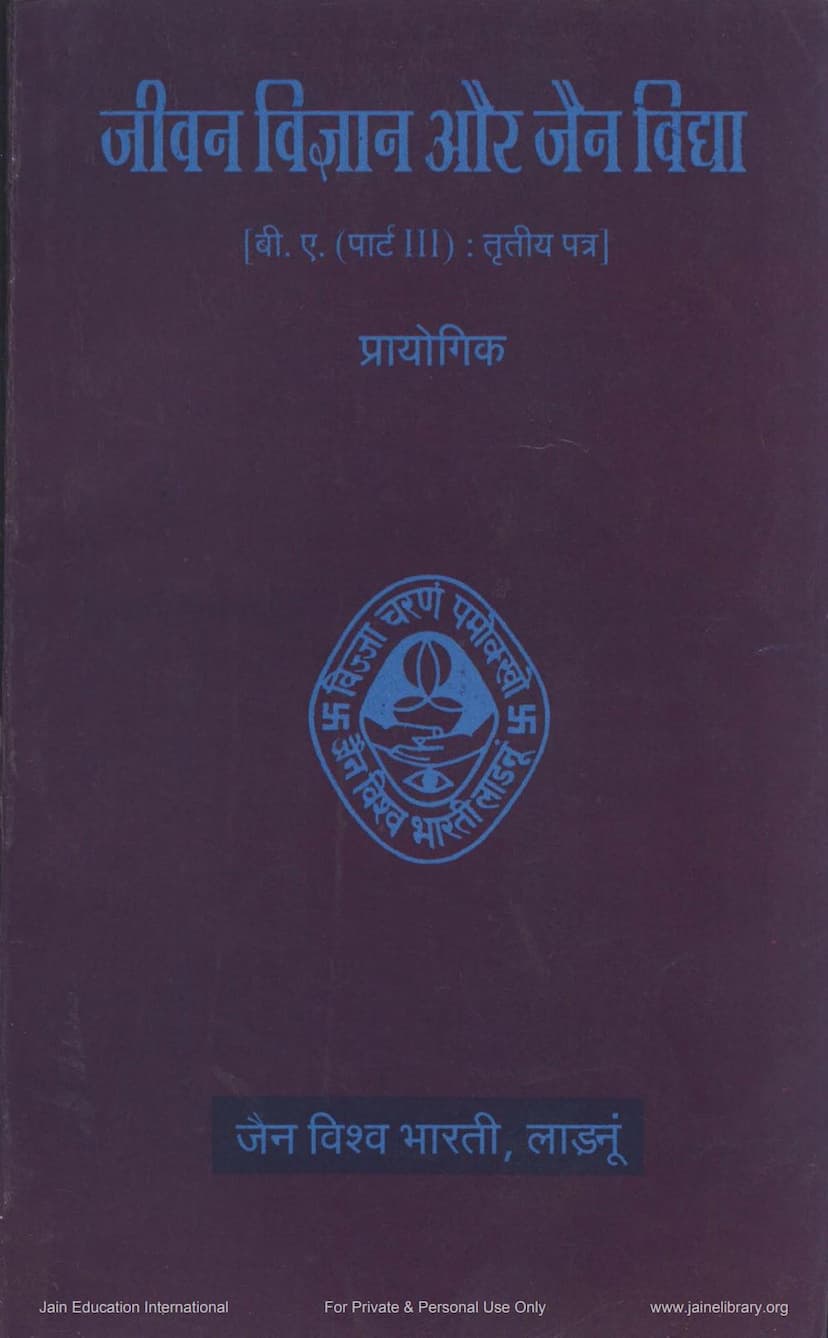Jivan Vigyana Aur Jain Vidya
Added to library: September 2, 2025

Summary
This document is a practical manual for the third paper of the B.A. (Part III) curriculum on "Life Science and Jain Vidya" by Mahapragna Acharya, published by Jain Vishva Bharati. The book is intended for private and personal use by students.
The preface highlights the growing concern in modern higher education for value-based education and the need to address the character vacuum in academic institutions. It praises Ajmer University for incorporating "Life Science - Jain Vidya" into its B.A. curriculum, emphasizing that practical exercises are crucial for character building.
The book focuses on the practical aspects of the curriculum, which includes six main practice modules:
- Yogasana (Yoga Postures)
- Pranayama (Breathing Exercises)
- Yogic Kriyaen (Yogic Practices/Cleansing Techniques)
- Kayotsarg (Self-Observation/Body Stillness)
- Preksha Dhyana (Mindful Meditation)
- Anupeksha (Contemplation/Insight)
The manual details specific practices within these modules, aiming to provide students with the knowledge to not only perform these exercises but also to guide others. The introductory sections for each section emphasize the importance of understanding the methods thoroughly and practicing them regularly for desired results.
Key Sections and Practices Covered:
-
Asanas (Yoga Postures): The book details the methods, benefits, precautions, and physiological effects of several asanas, including:
- Pawanmuktasana (Wind-relieving pose)
- Bhujangasana (Cobra pose)
- Dhanurasana (Bow pose)
- Sarvangasana (Shoulder stand)
- Halasana (Plow pose)
- Matsyasana (Fish pose)
-
Pranayama (Breathing Exercises): It covers the techniques and benefits of:
- Bhastrika (Bellows breath)
- Keval Kumbhaka Pranayama (Breath retention)
- Kapalbhati Pranayama (Skull-shining breath)
-
Yogic Kriyaen (Yogic Practices): This section outlines specific movements and exercises for various body parts to improve flexibility, circulation, and energy flow. These include practices for the:
- Head (Mastak)
- Eyes (Ankh)
- Ears (Kan)
- Mouth and Voice Box (Mukh evam Swaryantra)
- Neck (Gardan)
- Shoulders (Skandh)
- Hands (Haath)
- Chest and Lungs (Seena aur Phephde)
- Waist (Kamar)
- Legs (Pair)
- Knees and Feet (Ghutne evam Panje)
-
Kayotsarg (Self-Observation/Body Stillness): This section provides a detailed, multi-stage practice of Kayotsarg, including preparatory steps, bodily relaxation, and a focus on experiencing stillness and lightness. It emphasizes a deep state of awareness and release of tension.
-
Preksha Dhyana (Mindful Meditation): This module introduces various meditation techniques:
- Leshya Dhyana (Aura Meditation): Focusing on specific colors (green for joy, blue for discipline, red for insight, yellow for knowledge, white for peace) associated with different energy centers (chakras) to influence emotions and mental states.
- Layabaddha Deergh Shwas (Rhythmic Deep Breathing): Practicing controlled breathing with specific durations for inhalation, retention, and exhalation.
- Bhavkriya evam Mansik Jagrukta (Emotional Action and Mental Awareness): Focusing on living in the present moment, performing actions with full awareness, and maintaining constant vigilance (apramad). This section also includes practical exercises for developing awareness and concentration.
- Ekagrata ke Vividh Prayog (Various Concentration Exercises): Simple deep breathing, deep breathing with Khechari Mudra, and deep breathing with breath retention.
- Avadhan (Smriti) ke Prayog (Memory Exercises): Techniques for improving memory through number recall and word recall, utilizing methods like associating numbers with letters and forming words or sentences.
-
Anupeksha (Contemplation/Insight): This section delves into introspective practices aimed at developing specific perspectives and virtues:
- Ekatva Anupeksha (Contemplation of Oneness/Aloneness): Focusing on the understanding that one is fundamentally alone in their experiences.
- Anyatva Anupeksha (Contemplation of Otherness): Differentiating oneself from the physical body and material possessions.
- Kartavyanishtha ki Anupeksha (Contemplation of Duty/Commitment): Developing a sense of duty and ethical conduct.
- Swavalamban ki Anupeksha (Contemplation of Self-Reliance): Fostering independence and self-sufficiency.
- Sampraday-Nirapeksha ki Anupeksha (Contemplation of Non-sectarianism): Cultivating an open and inclusive perspective towards different beliefs and traditions.
- Dhairya ki Anupeksha (Contemplation of Patience): Developing the capacity to endure and wait.
- Anasakti ki Anupeksha (Contemplation of Non-attachment): Reducing attachment to material possessions and experiences.
Each Anupeksha practice includes a specific methodology involving Mahaprana Dhwani (deep resonant chanting), Kayotsarg, colored breathing, meditation on specific chakras, recitation of specific phrases, contemplation on related philosophical points, and concluding with Mahaprana Dhwani.
The book also includes sections on the "Influence on Health" and "Influence on the Glandular System" for asanas and pranayama, explaining their physiological effects and therapeutic benefits. It provides guidelines for teachers on how to conduct practical sessions, including re-emphasizing previous lessons, ensuring students can perform and teach the exercises, memorizing terminology, using effective instruction styles, and maintaining practical notebooks.
Overall, "Jivan Vigyana aur Jain Vidya" is a comprehensive guide that integrates yoga, meditation, and philosophical contemplation rooted in Jain principles, aiming to promote holistic personal development and character building.